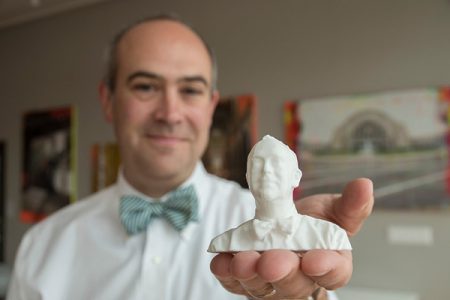I sat down with Eric Avner of The Haile Foundation in early December, at their People’s Liberty office in OTR, to get a sense of the man, what he does at Haile, and the like. We weren’t doing a formal interview; we had a very mutually participatory conversation about the state of the arts and community development in the Greater Cincinnati region, and his role(s) within this foundation to enhance their goals (which are mainly in Arts and Culture; Community Development; Education; and Human Services). The Foundation is named for the late Carol and Ralph Haile, who, in leaving their fortune as a foundation for the betterment of this community, have truly changed the direction of this region itself.
People’s Liberty is a very cheerful place to work; it’s a highly creative place, with ideas and people literally crackling in the air. When I arrived, Eric Avner was just finishing up some work with two young people, and the large one-room work space was bristling with, as they say today, good energy. Mr. Avner, who has a background working for the Cincinnati Business Committee (CBC), exudes high energy and creativity; his mind works even faster than his brain seems to, as he delved into many topics ranging from the bureaucratic nature of many funding venues here, to his/Haile’s vision for a truly new , creative and vital Greater Cincinnati region.
In rather direct contrast to other established foundations and funders, Haile seems able to move more quickly, is as unbureaucratic as an institution can be; ideas literally fly around. What their main thrust seems to be is community development, looking at this region in an interdisciplinary fashion, cutting across established boundaries, moving Greater Cincinnati forward from its conservative corporate background into a progressive region in which creative people will seek to live and work. (Haile’s most recent phenomenon was BLINK, the four day light-up-Cincinnati-buildings festival, which lasted for three days last October and brought a million people into downtown and OTR: BLINK was the child of Haile President Tim Maloney, and is indicative of how much can grow out of a small organization with tentacles all over this region. With more and more new immigrants arriving in this region, Haile is looking for ways/projects in which our new neighbors can become more quickly and creatively integrated into their neighborhoods; for example, Wave Pool Gallery in Camp Washington is a recent recipient of Haile largesse, as they’ve truly tried and succeeded in reaching out far into the neighborhood in which they find themselves with creative programming and wide community involvement. As the arts in general have been moving more and more into Social Justice, Women’s Issues and Poverty Initiatives (as the new Rosenthal Family Foundation puts it), Haile is in the forefront of leading, through wise and clever grant allocations, movements towards inclusivity and diversity in its true senses of the word. Haile can come up with funds quickly for creative projects and they do; they’ve been offering two $100,000 grants lately for any two people who come up with new big ideas to move this community forward. It’s clear that Avner is looking towards younger creatives to fulfill these missions, towards individuals rather than huge organizations and overly bureaucratized funding sources. Haile can thus be responsive to short term financial needs to move things along quickly. (I mentioned to Avner aeqai’s own attempts at securing funding from some existing funding entities and how we have felt blocked and/or shuffled away by some of them; aeqai has, incidentally, received three grants from The Haile Foundation in 2015, 2016 and 2017), and we were delighted not only to receive some seed money, but also by the ease of the application process, which was streamlined and simple). Haile is also able, in Avner’s words, to “leverage corporate strength”.
But Avner expressed his concerns about the weak form of government we have in Cincinnati, even with the direct election of the mayor which we’ve had for some years now. Concurrently, stronger philanthropic leadership would incubate more accountability and more leadership, as The Heinz Foundation has done in the completely rejuvenated city of Pittsburgh. Avner believes that we need, here, a different model of philanthropy, which I’ve also heard from Dick Rosenthal, where philanthropy harnesses people’s energy and strengths. Looking at cities which compare with Cincinnati, such as Louisville, Pittsburgh, Indianapolis, Detroit and Columbus, Cincinnati is not yet building on the strengths that those cities have been harnessing (note the recent loss of the possibility of an Amazon HQ2 in Cincinnati, but many of the above mentioned cities are still in the running: Cincinnati has long been prone, in my opinion, to have an overinflated view of itself). And we certainly do not have enough philanthropists here at this time: most of the major funders in the arts, for example, have died in the past five years; other foundations are closing, as their founders seek to keep their estates clean from endless paperwork after they’re no longer with us). I’ve been worried about a funding crisis here for years, now; The Baby Boomers, of whom I am one, are not nearly as generous a generation as our parents were; one hears a lot about owning multiple houses these days, and ownership of private jets is way up, while philanthropy is down).
Creativity and money are not the same things. Avner mentioned a Haile-sponsored Treasure Hunt, which took place over a year ago, where people went from one place and/or institution to another, following clues all ’round town–most of which were highly creative and often funny, but took people into and through all sorts of large institutions, to get a taste of Cincinnati, if you will. I mentioned former interdisciplinary projects, such as the old Arts ’85/’86/’87, which were highly creative collaborations between The Cincinnati Art Museum, Contemporary Arts Center, and Taft Museum of Art, and The Cultural Chow Line, which took place for five years in the ’80s, and was a $15 a head progressive dinner taking people to/through The Taft Museum, the then Historical Society adjunct at 4th and Walnut, The (old) Contemporary Arts Center and The Mercantile Library as another such example. So arts and culture become a vehicle in Haile’s vision for creating more and more senses of community, crossing boundaries and borders.
Avner is a brilliant and creative man, looking for partnerships with people and groups who share a vision of a transformed Greater Cincinnati region. The Haile Foundation, which is neither large nor remotely bureaucratic, is looking for transformation, for creativity and new leadership. And they put their money where their ideas are; they don’t so much think out of the box, as assume that there is no box needed to advance the kind of growth and vision which they possess and encourage the rest of us to utilize. My hour with Eric Avner was eye opening and heartening, as he represents a new generation of leadership here which values individual creativity and seeks to break through into a new vision of this region entirely: it’s no small idea, at all, and the Haile folks are up to it, indeed.
–Daniel Brown







